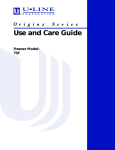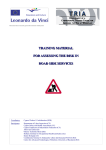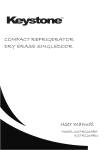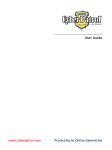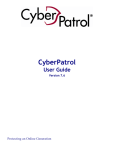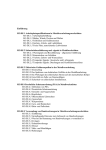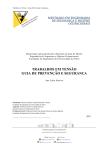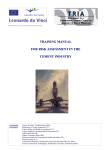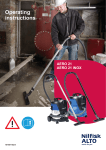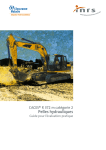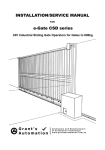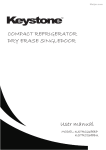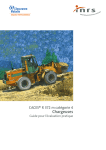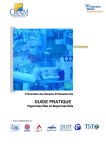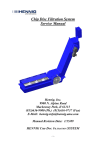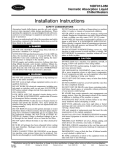Download training material for assessing the risk in metal processing workshops
Transcript
This document does not necessarily represent the Commission’s official position T TR RA AIIN NIIN NG GM MA AT TE ER RIIA AL L FFO ER RIISSK K IIN NM ME ET TA AL L OR RA ASSSSE ESSSSIIN NG GT TH HE PPR RO OC CE ESSSSIIN NG GW WO OR RK KSSH HO OPPSS Coordinator: Cyprus Workers’ Confederation (SEK) Participants: Department of Labor Inspection (CY) Cyprus Safety and Health Association (CY) Cyprus Employers & Industrialists Federation (CY) Arbeit und Leben (D) Odense Techniske Skole (DK) Hellenic Institute for Occupational Health and Safety (EL) Kauno Kolegija (LT) Confederatia National A Sindicatelor Libere din Romania-FRATIA (RO) Center for Advanced Technologies, Politechnic University of Bucharest (RO) TABLE OF CONTENTS M3-EN INTRODUCTION Μ3-EN.1 WORKPLACE SPECIFICATION M3-EN.1.1 Workplace ventilation M3-EN.1.2 Floor, Walls, Ceilings, Roofs M3-EN.1.3 Falls from height, dangerous zones M3-EN.1.4 Docks and handling-loading platforms M3-EN.1.5 Free space, suitable air volume M3-EN.2 HEALTH AND SAFETY SIGNALLING M3-EN.2.1 Labelling – General introduction M3-EN.2.2 Signs characteristics M3-EN.2.3 Prohibition, warning and mandatory signs M3-EN.2.4 Temporary signalling- Acoustic and lighting signals M3-EN.2.5 Temporary signalling- Announcement and gesticulation signs Μ3-EN.3 ELECTRICAL HAZARD Μ3-EN.3.1 Electrocution Μ3-EN.3.2 The spectrum of electrical accidents in metal processing Μ3-EN.3.3 The effects of electric current on human body Μ3-EN.3.4 First aid in case of electrocution Μ3-EN.3.5 Safety in electrical installations Μ3-EN.4 PERSONAL PROTECTIVE EQUIPMENT M3-EN.4.1 Definition of PPE M3-EN.4.2 Personal Protective Equipment M3-EN.4.3 Face and Eyes M3-EN.4.4 Head M3-EN.4.5 Ears M3-EN.4.6 Respiratory protection M3-EN.4.7 Body M3-EN.4.8 Arms and hands M3-EN.4.9 Legs and feet M3-EN.5 USE OF HAND TOOLS M3-EN.5.1 Introduction M3-EN.5.2 Basic tips for the use of hand tools M3-EN.5.3 What must be avoided when using hand tools M3-EN.5.4 Clamps M3-EN.5.5 Cutters M3-EN.5.6 Knives M3-EN.5.7 Wood and metal saws M3-EN.5.8 Pipe wrenches M3-EN.5.9 Wrenches, screwdrivers, hammers and sledges M3-EN.5.10 Powered hand tools M3-EN.6 SLIPS AND TRIPS M3-EN.6.1 General information M3-EN.6.2 Safety practices M3-EN.7 NOISE M3-EN.7.1 Noise in Metal Processing Workshops M3-EN.7.2 Noise limitation M3-EN.7.3 Examples of Noise reduction M3-EN.7.4 Intervention to already operating machinery M3-EN.8 SAFE USE OF EQUIPMENT M3-EN.8.1 Hazard sources and regulations for work equipment M3-EN.8.2 Operation systems – Control instruments M3-EN.8.3 Barriers M3-EN.8.4 Housekeeping M3-EN.8.5 Rotating equipment M3-EN.9 HAND-ARM VIBRATIONS M3-EN.9.1 Causes of health problems M3-EN.9.2 Detection of problems M3-EN.9.3 Preventive and safety measures M3-EN.10 SAFE USE OF CLEANING AGENTS M3-EN.10.1 Introduction M3-EN.10.2 Use of chemical cleaners and protective measures M3-EN.10.3 Personal protective equipment M3-EN.10.4 Hygiene M3-EN.10.5 Protection of public M3-EN.10.6 First Aid M3-EN.11 GAS WELDING M3-EN.11.1 Gases used in flame cutting and welding processes M3-EN.11.2 Gas cylinder handling M3-EN.11.3 Pressure regulators M3-EN.11.4 Flexible hoses M3-EN.11.5 Safety in metal welding processes M3-EN.12 USE OF LIFTING EQUIPMENT AND FORK LIFT TRUCKS M3-EN.12.1 Basic industrial forklift truck operation guidelines. (Part Α΄) M3-EN.12.2 Basic industrial forklift truck operation guidelines. (Part Β΄) M3-EN.12.3 Basic industrial forklift truck operation guidelines (Part C΄) M3-EN.12.4 Common deficiencies – remarks – Checklist M3-EN.13 METALWORKING FLUIDS M3-EN.13.1 What are metalworking fluids? M3-EN.13.2 Health effects M3-EN.13.3 Safe handling of metalworking fluids M3-EN.14 RISK ASSESSMENT TOOL M3-EN.15 WEB BIBLIOGRAPHY M3-EN Introduction This module aims at assessing employee safety and health in a typical workplace in Metal Processing Workshops. The module covers the following topics: • Detailed analysis of hazards present in metal processing workshops is given with safety measures to prevent the risk where this is possible • Safety tips, requirements for personal protective equipment and recommended safety and health protection labels and signs are presented • Risk assessment tool in metal processing workshops with examples of good practice This module is arranged in such a manner that it might be used by a tutor in class and for self-study by any person interested in Health and Safety in Metal Processing Workshops. The participants during lectures make themselves aware of the types of hazards that an employee may encounter and perform risk assessment in a specific job. Μ3-EN.1 WORKPLACE SPECIFICATION M3-EN.1.1 Workplace ventilation M3-EN.1.2 Floor, Walls, Ceilings, Roofs M3-EN.1.3 Falls from height, dangerous zones M3-EN.1.4 Docks and handling-loading platforms M3-EN.1.5 Free space, suitable air volume Chapter Description In this chapter, the minimum specifications of a workplace are described according to the EU Directive 89/654. This chapter aims at the familiarization of those who are engaged in Occupational Health and Safety with the minimum specifications in a work place and especially in Metal Processing workshops, resulting in better workplace construction. M3-EN.1.1 Workplace Ventilation In metal processing workshops there should be adequate fresh air volume, having taken in mind the kind of the work (especially in the workplaces where welding is taking place) and the physical effort employee is putting. Air quality should be secured in base of hygiene (Μ3.01.01).In case that air renewal is being achieved through mechanical way (air conditioning), they should work continuously, being kept in well situation and every trouble must be specified (Μ3.01.02 and M3.01.03) Employees must avoid air streams produced by the ventilation system (M3.01.04 and M3.01.05) and should make sure that that improper air can be extracted from low height to a safe place in the open air away from people, sources of ignition and nearby buildings and equipment. Exposure to fumes involves health risks for the employees especially fumes from welding, chemical fumes, spray painting fumes and chape fumes. M3-EN.1.2 Floor, Walls, Ceilings, Roofs Floors should be stable, without dangerous slopes and adequately resistant. They should also have a drain, be resistant against corrosive chemicals and fire and should also have adequate vibration absorbing capacity. The covers of any sort of floor openings should be safely established (M3.01.06). If they are temporarily removed, proper labelling should be placed, to prevent slips and trips of employees. Any disorders (e.g. broken drains) in the floor must be immediately repaired. Walls surface must be easily cleaned (M3.01.07), plain-faced and liquid-proof (against metal liquids, cleaning chemicals, etc.), at least 1,5 meters from the floor. Any glass walls should be indicated and labelled clearly and be made of safe materials. In workshops where flames are used (e.g. welding), walls should be fireresistant. Ceilings must be easy for cleaning and maintenance (M3.01.08). 1 Roofs must be easy accessed. Suspension of weights from ceiling should only take place after an expert’s permission (M3.01.09). M3-EN.1.3 Fall from height, dangerous zones Working surfaces, corridors, loading bays, platforms and any other level placed above 0.75 metres should have a protective screen of 1.00 at least, either of compact structure or a fence with handrail, baseboard of 0.15 metres and a middle horizontal bar (M3.01.10). Anywhere there is case of fall, protective measures should be taken. Dangerous zones have to be identified (M3.01.11 and M3.01.12). M3-EN.1.4 Docks and handling-loading platforms Docks and loading platforms should be of proper size with a minimum width of 0.80 m. If is possible they should also have a rain screen and at least one exit along their frontage (if their length is above 20 metres two exits, one for each side). These exits should be stable. In certain cases where the level of the dock is higher than 0.75 metres, there should be a protective arrangement (though not a compact wall or fence). This kind of arrangements (portable fences) should be placed also near loading platforms in such way that would serve the easy handling of bulks. They may be convertible and easily basifugal. M3-EN.1.5 Free space, suitable air volume All workplaces should have adequate surface, size, height and air volume that will permit employees to do their job without danger. The size of the workplace should fill all requirements. They should provide safety both for normal everyday tasks, maintenance, fixing or installation of equipment. In all cases, the size of the workplace must allow employees to move through bulky equipment or materials that would be present. 2 M3-EN.2 HEALTH AND SAFETY SIGNALLING M3-EN.2.1 Labelling – General introduction M3-EN.2.2 Signs characteristics M3-EN.2.3 Prohibition, warning and mandatory signs M3-EN.2.4 Temporary signalling- Acoustic and lighting signals M3-EN.2.5 Temporary signalling- Announcement and gesticulation signs Chapter Description In this chapter, the minimum signs in a workplace are described according to the EU Directive 92/58. This chapter aims at the familiarization of those who are engaged in Occupational Health and Safety with the signs used in a workplace and especially in Metal Processing workshops, resulting in health and safety of the employees. M3-EN.2.1 Labelling – General introduction In metal processing workshops and especially in a workplace where many metallourgic proceedings are taken place, signalling is very important not only for the employees of the workshop but for the clients and visitors too. Signs are something more that just necessary because signs inform for the potential dangers that can appear in the workplace. All kinds of signs- prohibition, warning and mandatory- are compulsory to be placed according to certain legislation. These involve the use of acoustic and lighting signs, gesticulation signs, announcements and chemical substances labelling. Inextricable part of health and safety signalling is also fire safety and warning signs together with marking for dangerous location. M3-EN.2.2 Signs characteristics Signs characteristics are: • simple for easy understanding • proof and hardy • colours and size must be appropriate to the workplace size Use of signs: • Must be placed in a proper height, so that can be seen from any point in the workplace • Colours must be bright and if daylight is inadequate, artificial light should be used • Signs must be taken off when the certain risk is no longer present • A poster with all the signs and their explanation should exist, preferably in areas where employees are gathered for breaks 1 M3-EN.2.3 Prohibition, warning and mandatory signs Prohibition signs characteristics: • They prohibit employees of doing a specific work • They are round-shaped, with a black symbol on white background with a red contour which should cover the minimum of 35% of sign surface • They should have a red erasure line with 45 degrees inclination (Μ3.02.01, Μ3.02.02, Μ3.02.03, Μ3.02.04, Μ3.02.05, Μ3.02.06, Μ3.02.07, Μ3.02.08) Warning signs characteristics: • They warn of a specific danger • They are triangle-shaped with a black symbol on yellow background with black contour which should cover the minimum of 50% of sign surface (Μ3.02.09, Μ3.02.10, Μ3.02.11, Μ3.02.12, Μ3.02.13, Μ3.02.14, Μ3.02.15, Μ3.02.16, Μ3.02.16, Μ3.02.17, Μ3.02.18, Μ3.02.19, Μ3.02.20, Μ3.02.21, Μ3.02.22, Μ3.02.23, Μ3.02.24, Μ3.02.25, Μ3.02.26) Mandatory signs characteristics: • They indicate a specific action • They are round-shaped with a white symbol on blue background, which should cover the minimum of 50% of sign surface. (Μ3.02.27, M3.02.28, M3.02.29, M3.02.30, M3.02.31, M3.02.32, M3.02.33, M3.02.34, M3.02.35, M3.02.36, M3.02.37) M3-EN.2.4 Temporary signalling- Acoustic and lighting signals Temporary signalling should be used when: • There is an emergency • It is necessary to call someone for a specific action • To evacuate in case of emergency • To guide someone to do some conduct Acoustic signal characteristics: • The sound level should be higher than the background and different than the other sounds of the workplace • The sound should be easily recognized • The sound should have unsteady frequency • Combined use of two different signals should be avoided • The electric current should be continuous and in case of blackout there should be another energy source • Signal sources should be carefully installed and maintained 2 Lighting signals characteristics: • There should be appropriate contrast to avoid eye problems • One colour must be used (usually orange and red are preferable) • Signal should be intermittent to spot danger • Signal should be easy recognized • The electric current should be continuous and in case of blackout there should be another energy source • Signal sources should be carefully installed and maintained M3-EN.2.5 Temporary signalling- Announcement and gesticulation signals Announcement characteristics: • Brief, simple and clear messages • The user should be knowledgeable about the language used in the particular workplace • Words-passwords should be used for instance start, stop, end, forward, etc Gesticulation signals characteristics: • Signalman: the person who guides • Crane man: the person who receives the signals • The signal must be simple, justified, easy recognized Signalmen duties: • They wear suitable clothes with luminate finishing, helmet and carry rackets • They give specific instructions to the crane man • They are responsible for the other employees round the crane General gestures: • Start: Stretch of the two arm in front of the body, in parallel position and the flat of the hand upwards • Stop: Stretch upwards the right arm and the flat of the hand forwards • End: Both arms united on the chest Vertical gestures: • Lift: The right arm is stretched upwards and the flat of the hand curves • Down: The right arm is stretched downwards and the flat of the hand curves • Vertical distance: The flats of the hands in parallel position show the distance Horizontal gestures: • Move forward: The two arms joined with the flats face each other move towards the body in slow motion 3 • Move backwards: The two arms joined with the flat face each other move away from the body in slow motion • Move right: The right arm stretched right horizontally with the flat of the hand downwards moving towards the body • Move left: The left arm stretched left horizontally with the flat of the hand downwards moving towards the body • Horizontal distance: The flats of the hands in parallel position show the distance 4 Μ3-EN.3 ELECTRICAL HAZARD Μ3-EN.3.1 Electrocution Μ3-EN.3.2 The spectrum of electrical accidents in metal processing Μ3-EN.3.3 The effects of electric current on human body Μ3-EN.3.4 First aid in case of electrocution Μ3-EN.3.5 Safety in electrical installations Description of chapter The specific chapter deals with issues concerning the potential electrical hazard at metal processing workplaces, particularly focusing on electrocution accidents, the means of preventing electrical hazard, the impact of electric current flowing through human body, first aid measures and general safety guidelines. Μ3-EN.3.1 Electrocution Electrocution happens when electric current flows through human body while the latter becomes part of an electrical circuit, which has a voltage capable of overcoming the body’s (electrical) resistance. The most crucial factor regarding injury is the quantity of electric current passing through human body. An electrical accident usually occurs because of a direct (or indirect) contact with a bare wire or another live part of a circuit. On the other hand, in some cases, the approach of human body, especially when holding a conductive object, near a strong electromagnetic field may prove evenly dangerous. Μ3-EN.3.2 Range of electrical accidents in metal processing workplaces. Electrical accidents in metal processing may be classified into three categories: • Electrical accidents caused by the direct effects of electric current on human body. These accidents include contact with: o plugs or sockets connected to eclectic hand tools such as drills, angle grinders, or other supplementary appliances like refrigerators, water boilers, etc o cables damaged by overheating due to overload, by exposure to harsh weather conditions (high temperatures, moisture), especially in outdoors installations, cables run over by vehicles on passageways, or even damaged by various rodents (rats, etc) o Battery poles found on eclectic vehicles such as fork lift trucks, loading vehicles etc o Step down transformers found in power substations. This is the case of industrial installations supplied directly with high voltage from the grid o Metal body of machinery like presses, cutting machines and generally all metallic surfaces, which are not properly earthed o Any machine due to a fault during maintenance procedure 1 • Indirect contact and skin burns caused by high thermal load originating from an eclectic arc. These accidents are prone to happen in larger industrial plants or some specific small workshops, mostly in the vicinity of power substations, usually accessed by qualified personnel only • Minor accidents usually caused by weak (low voltage) currents, which may result for example in slipping or falling due to a panic reaction. This sort of accidents may happen during the replacement of light bulbs, or during various repairs performed in height, such as maintenance of air conditioning units, or fume extractors Μ3-EN.3.3 Effects of electric current on human body It is worth mentioning that the effects of electric current are a function of its intensity (measured in Amperes – A). Currents on the order of 0,9 to 1,2 mA are hardly perceptible. At higher intensities like 10 - 15 mA women can no longer release the live object, thus appearing the “grabbing effect”. At values as high as 20 to 45 mA, muscles begin to cringe violently and painfully. If this contracture reaches the thoracic muscles, respiration is suppressed, a fact that may lead to death from asphyxiation. In the latter case, the only feasible means of recovery is performing C.P.R. (artificial respiration) to the victim. Current values higher than 200mA = 0,2Α usually cause instant death. Μ3-EN.3.4 First aid in case of electrocution. • Move the victim away from the live part of the circuit by means of immediate power cut off, if this does not cause any severe problems (such as a total blackout, or interruption of operation of crucial equipment) • Avoid any contact whatsoever with the victim using bare hands. In order to move the victim, always use insulating objects • Never use pipes, gads or any other metal objects, commonly found at metal processing industries. Seek immediate medical attention • In case the victim does not breath, perform C.P.R and chest compressions Μ3-EN.3.5 Safety in electrical installations In order to work safely in metal processing plants, the following guidelines should be implemented: • The equipment maintenance should be always conducted be a licensed electrician, especially when heavy electrical load machinery, (heating and metal fusion kilns) is involved • Where possible reduce operating voltage at 42V, particularly when working inside moist areas, as well as close to cooling water tanks • Use isolation transformers (transform ratio 1:1), when working outdoors • Always use well insulated hand tools • All machinery having metal covers should be properly earthed 2 • Separation of electric circuits and use of multiple differential circuit brakers (one per circuit) for the effective protection of working personnel • Switch off power and place appropriate signs and labels before any maintenance work is performed • Always use explosion proof lighting fixtures wherever electric welding takes place or in areas where paints, solvents and other flammable substances are stored 3 Μ3-EN.4 PERSONAL PROTECTIVE EQUIPMENT M3-EN.4.1 Definition of PPE M3-EN.4.2 Personal Protective Equipment M3-EN.4.3 Face and Eyes M3-EN.4.4 Head M3-EN.4.5 Ears M3-EN.4.6 Respiratory protection M3-EN.4.7 Body M3-EN.4.8 Arms and hands M3-EN.4.9 Legs and feet M3-EN.4 Chapter Description In this chapter, Personal Protective Equipment is described. This chapter aims at the familiarization of those who are engaged in Occupational Health and Safety with the PPEs used in a workplace and especially in Metal Processing workshops, resulting in health and safety of the employees. M3-EN.4.1 Definition of PPE Every workplace has its own dangers for the health and safety of employees. Those dangers can be found in many points like sharp surfaces, falls, chemical substances, noise etc. The best way for the employees to be protected is to minimize the danger at the source. When this is impossible because of technical or economic problems then the employer should supply his employees with Personal Protective Equipment. Personal Protective Equipment: Every apparatus that a person should wear or bring to be protected from any danger that threats his health and safety. The Personal Protective Equipment includes apparatus, which protect employees from injuries or accidents and minimize the risk of exposure to chemical substances. The PPEs are made to protect: • The eyes • Hearing • The face • The respiratory system • The head • The legs and feet • The arms and hands • The whole body 1 M3-EN.4.2 Personal Protective Equipment There are many PPEs to mention for instance like, goggle, respirators, helmets, safety shoes, safety gloves, working clothes. The PPEs should fit the special characteristics of the user. The majority of those PPEs are capable at many sizes so the employee can choose the right for him. Moreover, it is important to take into consideration the compatibility of the different PPEs. In a Metal Processing Workshop, there are many dangers that oblige employer to buy some PPEs for the employees. M3-EN.4.3 Face and Eyes Some potential dangers in a metal processing workshop that can cause severe damage to employee’s eyes and face are the existence of pendulous particles- particularly metallic dust from cutting works, dressing and processing- hot splashes from molten metal and other hot liquids, fog and organic vapours, metallic colours, radiation from welding etc. The selected form of eye protection at a workplace must be appropriate to the work being performed and properly fits each worker exposed to the hazard. Employees wearing corrective lenses or contact lenses are not being protected from eye hazards. Therefore, they must use eye protective equipment that incorporates with the prescribed lenses they use. It is important to make sure that the protective eyewear does not disturb the proper positioning of the prescription lenses, and that the employee’s vision will not be inhibited or limited. Some of the most common types of eye and face protection are given below: − Safety spectacles - These protective eyeglasses have safety frames constructed of metal or plastic and impact-resistant lenses. Some models have side shields (M3.04.01) − Goggles - These tight-fitting eye protections completely cover the eyes, eye sockets and the facial area immediately surrounding the eyes and provide protection from impact, dust and splashes. There are several types of goggles fit over corrective lenses (M3.04.02) − Welding shields - Constructed of vulcanized fibre or fibreglass and fitted with a filtered lens, welding shields protect eyes from burns caused by infrared or intense radiant light; they also protect both the eyes and face from flying sparks, metal spatter and slag chips produced during welding, brazing, soldering and cutting operations (M3.04.03) − Laser safety goggles - These are specific goggles protecting against intense concentrations of light produced by lasers. The type of laser safety goggles an employer chooses depend on the equipment and operating conditions in the workplace − Face shields - These are transparent sheets of plastic extend from the eyebrows to below the chin and across the entire width of the employee’s head. Some are polarized for glare protection. Face shields protect against dusts and potential splashes or sprays of hazardous liquids but will not provide adequate protection against impact hazards. Face shields used in combination with goggles or safety spectacles will provide additional protection against impact hazards (M3.04.04 and M3.04.05) 2 M3-EN.4.4 Head A very important part of the body prone to accidents is the head. A serious damage on the head can cause from partial loss of memory to loss of conscience and even death. The most appropriate way for head protection is the use of a helmet. It can protect the head from falling objects, bump with stable surfaces etc. The appropriate helmet for a metal processing workshop should absorb all vibration from the bump, be waterproof and slow firing (M3.04.06). M3-EN.4.5 Ears Where noise levels exceed the standards, ear protection must be provided and used. A variety of effective hearing protection exists, so that employers can choose the proper hearing protective equipment. The choices are: • Earmuffs, which completely cover the ear (M3.04.7 • Earplugs, which are inserted in the ear canal (M3.04.08) • Semi-inserts (called ‘canal caps’), which cover the entrance to the ear canal M3-EN.4.6 Respiratory protection In a metal processing workshop there are vapours and gases from the use of organic solvents and cutting metal fluids. At the same time there are vapours from cutting works and welding, while particles flying in the air especially metallic dust. So it is essential the use of respiratory protection. Respirators protect the user in two main ways. The first is by the removal of contaminants from the air. Respirators of this type include particulate respirators, which filter out airborne particles (M3.04.09); and "gas masks” which filter out chemicals and gases (M3.04.10 and M3.04.11). Some other respirators protect by the supply of clean and respirable air from another source. Respirators that fall into this category include airline respirators, which use compressed air from a remote source; and self-contained breathing apparatus (SCBA), which include their own air supply. Respirators should only be used as a last protective measure when engineering control systems are not sufficient. Engineering control systems, such as adequate ventilation or scrubbing of contaminants should be used to negate the need for respirators. In some cases like fire there should be respiratory apparatus to help employees to escape the danger and the smoke. M3-EN.4.7 Body Personal protective clothing equipment, should be safely designed and constructed, and should be maintained in a clean and reliable fashion. Employees in Metal Processing Workshops may meet a variety of threats for their body and skin. Examples of body protection include laboratory coats, coveralls, vests, jackets, aprons, surgical gowns and full body suits (M3.04.12, M3.04.13 and M3.04.14) . In order to obtain adequate protection, this should be made of material with high resistance to such aggressive substances as concentrated acids (sulphuric, nitric, etc) and liquid condensed gases (chlorine, ammonia, etc). The protection should be in the form of a single overall that can provide a gas-tight unit. Boots worn must also be sealed to the overall. 3 M3-EN.4.8 Arms and hands If a metal processing workplace hazard assessment shows that employees face potential injury to hands and arms that cannot be eliminated through engineering and work practice controls, employers must ensure that employees wear appropriate protection. Potential hazards include skin absorption of harmful substances, chemical or thermal burns, electrical dangers, bruises, abrasions, cuts, punctures, fractures and amputations. Protective equipment includes gloves, finger guards and arm coverings or elbow-length gloves. A variety of gloves exists for the protection against several hazards. The way gloves will be selected, depends on the type of the hazard and the operation involved. Gloves: • Against physical impacts (M3.04.15 and M3.04.16) • Against chemical impacts (M3.04.17) • For electrical dangers • For protection from heat (M3.04.18) M3-EN.4.9 Legs and feet When employees might face possible foot or leg injury, then protective footwear should be used. Injuries might occur as a result from falling or rolling objects, or from crushing or penetrating materials. Some examples of situations in which an employee should wear foot and/or leg protection are among others: − When heavy objects (barrels or tools) might roll onto or fall on the employee’s feet − Working with sharp objects such as nails or spikes that could pierce the soles or uppers of ordinary shoes − Exposure to molten metal that might splash on feet or legs − Working on or around hot, wet or slippery surfaces − Working when electrical hazards are present There are also “special purpose shoes”; such as electrically conductive shoes that provide protection against the build-up of static electricity; and foundry shoes that keep the isolate the feet from the extreme heat of molten metal, and keep hot metal from lodging in shoe eyelets, tongues or other shoe parts. As with all protective equipment, safety footwear should be inspected prior to each use. 4 M3-EN.5 USE OF HAND TOOLS M3-EN.5.1 Introduction M3-EN.5.2 Basic tips for the use of hand tools M3-EN.5.3 What must be avoided when using hand tools M3-EN.5.4 Clamps M3-EN.5.5 Cutters M3-EN.5.6 Knives M3-EN.5.7 Wood and metal saws M3-EN.5.8 Pipe wrenches M3-EN.5.9 Wrenches, screwdrivers, hammers and sledges M3-EN.5.10 Powered hand tools Chapter description In this chapter, hand tools used in this sector are presented along with general tips on their use. The aim of this chapter is to familiarize all parties involved in Occupational Health and Safety in metal processing about hand tools and their use. M3-EN.5.1 Introduction Frequent and serious accidents happening during use of hand tools require taking some measures about the use, maintenance and transport of them, so as to prevent risks for the user and other persons working in the same area. Injuries from hand tools include bruises, fractures, amputations, temporary or permanent eye injuries, etc. Sorts of hand tools There is a large variety of hand-tools for various work tasks. The most common of them are: 1. Holding tools like vises 2. Cutting tools like cutters and knives 3. Wood saws and metal saws 4. Pipe wrenches 5. Mounting tools like screwdrivers and wrenches 6. Struck tools like hammers and sledges 7. Powered hand tools like grinding wheels, cutting wheels, drills, electrical screwdrivers, etc 1 M3-EN.5.2 Basic tips for use of hand tools • Choose the right tool for each task. Substitutes increase the likelihood for an accident • Use tools that allow wrist to remain straight. Avoid using hand tools with a bent wrist • Ensure that all employees have been properly trained in safe use of hand tools • Use tools of good quality • Inspect tools for defects before use. Replace worn tools • Keep cutting tools sharp and cover their cutting edge with a proper cover so as to protect the tool and prevent injuries from unintended touch • Replace broken, cracked or torn handles of files, hammers, screwdrivers and chisels • Ensure that all shafts of tools such as hammers and axes are tightly fit in the head of the tool • Replace worn out jaws of wrenches, pipe wrenches and large nippers • Restore heads of striking tools (e.g. hammers, chisels, etc.) that have a “mushroom” shape or edges • Sharp tools (e.g. saws, firmer chisels, knives) that lie in cases should not exceed from the top of the case • Carefully maintain hand tools. Keep them clean and dry and carefully store after each use • Carry hand tools in proper cases to and from workplace • Always wear safety glasses and well fit gloves proper for the respective risk of each task • Keep work environment clean and tight in order to avoid accidents • Use a heavy belt or apron and hang tools in side and never behind the back M3-EN.5.3 What must be avoided using hand tools • Do not use tools for tasks they are not designed for. For example do not use screwdrivers as chisels or levers, wedges, gads or wrenches as hammers • Do not exercise too mush power or pressure on hand tools • Do not cut towards your side when using cutting tools • Do not hold the shaft of a cutting tool or screwdriver with hand • Do not wear large gloves for the use of hand tools 2 • Do not throw hand tools. They most be passed by hand, handle front directly to the employees • Do not carry tools in a way that requires use of hands when someone climbs a ladder or executes a dangerous task. If work takes place on a ladder or platform, tools must move up and down in a bucket or hand-to-hand • Do not carry sharp tools in pockets M3-EN.5.4 Clamps Ensure that the swivel in the edge of the worm screw rotates freely before use. Replace clamps with a bent frame. If possible replace any bent worm screw too Ensure that the pressure surface and clamp’s support parts are in full touch with the stock before screwing Use pads in C-clamps so as to avoid squeezing marks Unscrew clamps after work is completed. Clamps are for temporary works and for safe clamping only Keep all moving parts of the clamp slightly lubricated and tools clean to avoid sliding. Ensure there is no dirt in any part that comes in contact to the stock C-clamps to be stored hanged in shelves, not in drawers Do not use large clamps for their big neck only. There are small clamps with a big neck Never use clamps with a bent frame or worm screw Do not use wrenches, pipes, hammers or nippers to screw clamps. Use wrenches only in clamps specially designed for this use Do not lift or drag using a C-clamp. Use special clamps for these tasks. Do not use C-clamps for scaffolding M3-EN.5.5 Cutters Cut straight and vertically and hold the material in proper angle with the tool Prevent injuries from dashing metal by wrapping a cloth around cutter’s jaws. Swarfs can be dashed during cutting. The harder the metal the further they are dashed Warn everybody close for the risk of dashing swarfs Adjust and lubricate cutter and moving parts everyday for heavy use Do not use pads for tasks that require insulated handles. Pads are for comfortable not for electrical shock protection Do not use cracked, broken or loose (in jaws’ screw) cutters Do not cut diagonally 3 Do not twist cutters when cutting wires Do not hit with hammer or extend the length of the handle for better leverage Do not expose cutters to high temperature M3-EN.5.6 Knives Fingers must not come in contact to the blade Workers must not move holding a knife Do not abstract worker’s attention during execution of his/her work After work is completed the knife must be put back in the specified safe store There must be at least on person trained in first aid, especially when systematically works requiring use of knife are taking place. When this is not feasible due to limited personnel, at least someone must be trained in stopping bleeding Additionally, especially when knives are systematically used, all employees must know what to do in case of bleeding M3-EN.5.7 Wood and metal saws Choose a saw of proper shape and size for the specific task Choose a saw that keeps wrist in normal position Choose a saw with handle opening of at least 12 cm (5 in.) in length and 6 cm (2.5 in.) in width with an angle of 15° Check the processed material for nails, knobs and other objects that could destroy the flexible saw Start cutting by placing hands behind cutting spot with the thumb upwards and pressure on the blade. Start cutting cautiously and slow to avoid up rush in the blade. Drag upwards until blade “bites”. Start with partial cut and then bring the blade in the proper angle Clamp the processed part stable in its position Use a supporting part or a clamp to support any big processed part if required. Keep teeth and blade clean Protect saw’s teeth when not used Secure blade with teeth forward. Keep blade straight and frame properly aligned Cut with strong and stable strikes to the opposite side of the user Use all the length of the blade in every strike Use light lubricant in the blade not to overheat and break Hard materials to be cut slower 4 M3-EN.5.8 Pipe wrenches Choose a pipe wrench with sufficient opening and length for each task Use wrenches for holding or screwing pipes but never for bent or lifting of a pipe Adjust the pipe wrench handle to keep a small gap between the backside of the jaw and the pipe. In this way, pressure is concentrated in the teeth of the jaws producing the top clamping force. It also helps lock in screwing Inspect periodically pipe wrenches for worn or unsafe parts and replace (e.g. check for worn thread in the ring and the moving jaw). Keep pipe wrench’s teeth clean and sharp Twist pipe wrench before use so as press to be applied in heel jaw Pull rather than push pipe wrench’s handle. Keep proper body position with legs close to keep balance Do not use pipe wrench as a hammer neither hit it with a hammer Do not use pipe wrenches in nuts and bolts M3-EN.5.9 Wrenches, screwdrivers, hammers and sledges Replace wrenches that look worn Always have enough wrenches of the proper size Do not use pipes for extension Always choose a screwdriver with a proper handle to prevent sliding of hand Do not screw or unscrew holding parts with hand. They must always be stabilized in a stable surface Small parts that have to be screwed must be stabilized with a clamp Knives or other sharp objects must not be used to screw Choose the proper screwdriver head depending on the sort of screw Hammer’s or sledge’s metal be well fit on the shaft that must be in perfect condition (M3.05.01) Use a protective pad by rubber to protect hand M3-EN.5.10 Powered hand tools Risks from the use of electrical power tools mainly concern: 1. Electrical power 2. Moving parts, especially when used without safety systems 3. Use of tools with different parts from those prescribed by the producer 4. Dashing particles of material (swarf) 5 General advices for safe use of electrical power tools Keep all tools grounded Especially small portable tools must be grounded for more safety When using portable tools, use gloves and specific shoes that provide electrical shock protection In humid places prefer to use low voltage power Machines, cables and plugs must always be in good shape or else not to be used Avoid using them in places where there is suspicion or indication for highly flammable materials or gases because there is danger for fire or explosion Use no tool without its safety systems Use only parts and materials prescribed by the producer Always use personal protection equipment 6 M3-EN.6 SLIPS AND TRIPS M3-EN.6.1 General information M3-EN.6.2 Safety practices Description of chapter The specific chapter includes a general presentation of safety principles regarding slipping, while at the same time a prevention system applicable by the safety engineer is developed, as well as safety practices in order to avoid such minor accidents. The objective of this chapter is to familiarize all personnel involved in occupational health and safety at metal processing installations, with the safety rules and practices that should be implemented in order to avoid slips and trips at workplace. M3-EN.6.1 General information • The most important feature regarding slips and trips at metal processing workshops is often unsuitable building indoor space arrangement and cleanliness of a particular workplace • Swarf, waste, metalworking fluids, oil, etc, usually constitute a potential hazard for workers due to slippery floors. Thorough cleaning, and immediate removal of all hazardous substances (oil, water, etc) spilled on the floor is strictly required • Electric tool cables or electric welding unit cables are also possible causes of falls or stumbles Slips and trips are the most common causes of accidents. They are related to approximately 1/3 of occupational accidents. Moreover, they represent the major accident cause among visitors of an industrial site (clients, associates etc). M3-EN.6.2 Safety practices • All metal workers should be sufficiently informed and trained concerning the use of personal protective equipment and cleaning equipment • Suitable footwear should always be used • Cleaning and maintenance of workplace and equipment should take place frequently, as well as immediately after a leak or a spill occurs. In case the leak consists of a greasy substance, a suitable detergent must be used. After cleaning, the floor remains wet for some time, so a means of notifying personnel in the area is necessary • Sufficient lighting is considered crucial for the early detection of any obstacle or slippery surface at workplace. Particular attention should be paid regarding staircases, ramps (preferably equipped with banisters), or areas where manual handling takes place. Lamps should be cleaned frequently and replaced regularly • Check floor surface for broken tiles or sections, or any other damage 1 • Keep passageways free of obstacles and floors free of hand tools or other objects • Maintain order and tidiness inside workshop. If existing obstacles cannot be removed, warning labels and protective bars or banisters should be installed • Areas in the vicinity of machines should be adequately marked, so that no obstacle is accidentally placed close to them • Locate equipment so that electric cable runs are away of corridors or passageways. Wherever applicable, cables should be properly mounted on a surface and adequately sheltered • Restrict access to people wherever the above is not possible • Adopt suitable treatment of smoke, dust etc, which obstruct visibility • Make sure that not all objects or tools having sharp edges are exposed (metallic bars, open shelves etc). Objects below the knee height are usually difficult to spot 2 M3-EN.7 NOISE M3-EN.7.1 Noise in Metal Processing Workshops M3-EN.7.2 Noise limitation M3-EN.7.3 Examples of Noise reduction M3-EN.7.4 Intervention to already operating machinery Chapter Description In this chapter, the presence of noise in Metal Processing Workshops, together with the problems is explained. Finally, the noise reduction measures are presented. This chapter aims at the familiarization of those who are engaged in Occupational Health and Safety to noise in a workplace and especially in Metal Processing workshops, resulting in health and safety of the employees. M3-EN.7.1 Noise in Metal Processing Workshops In a metal processing workshop it is easy to find noise. Work positions like cropper, where noise is instantaneous and acute, lathe and drill, where noise is continuous. Hand tools and more specific the electrical ones generate great levels of noise. Grinding wheels and lathe may generate noise near 100 dB(A). The bump of two metal leaves, metal forging and metal cutting are noisy too. For example, flamecutting processing has measured to generate noise at a level about 93 dB(A). M3-EN.7.2 Noise reduction Installation of machinery design: • The study of noise protection can be a part of a general study and design (airconditioning, heating) • The source of noise should be installed separately, so the noise could not pervade around the workplace • Offices and control rooms should be separated with insulating materials, so employee could easy concentrate without any disturbances. There should be places where employees can rest themselves without noisy disturbances. The whole plan of the workplace should help that noise echo is avoided Choice and machinery installation: • • Noiseless engines should be installed when employer gets machinery. Hydraulic equipment should be chosen, oil tanks must be installed away of workplaces with employee’s presence and the flow must be in slow velocities with a maximum of 5 m/sec • All the information needed for noise level of machinery should be provided by the supplier 1 M3-EN.7.3 Examples of Noise reduction At a ventilation system one can intervene to the ventilators changing them with others noiseless. Someone can achieve this when he keeps away the control panels from the ventilators. Another way is to normalize the edges of the ventilator. The employer can minimize vibration so the noise generated from it to be minimized. For instance, a steely surface can generate vibration with two leaves and between them can be intervened an absorptive material (M3.07.01 and M3.07.02), achieving a reduction in noise level. Nutation of solid materials can be reduced if some metallic parts of equipment are replaced with plastic ones. M3-EN.7.4 Intervention to a machinery already in operation It is the most difficult and costly way to reduce noise levels, because these interventions could stop the whole production line and in some cases they are not feasible at all. For example, changing the way machinery (generator, punch press) is installed on the floor is almost impossible due to technical and economical reasons during this change, whereas it was far easier during the initial installation (M3.07.03). Case studies When a workplace includes large surfaces made of hard materials (on the ceilings, on the floor, on the walls), noise echoes are generated. In this case it is proposed to sheathed surfaces with absorptive materials. Machinery case: • Externally, thicker materials can be used, like a metal sheet or floating screed • Internally of the above structure an absorptive material can be used and have a noise reduction about 15-20 Db Occasionally when an electric engine should be insulated, sheets of absorptive material can be installed at the opens of cold air. Ventilation pipes should be designed with absorptive materials to trap noise (M3.07.04, M3.07.05, Μ3.07.06 and M3.07.07). In control rooms there should be heavy-duty absorptive materials (M3.07.08), so the operators can avoid noise causing accidents. 2 M3-EN.8 SAFE USE OF EQUIPMENT M3-EN.8.1 Hazard sources and regulations for work equipment M3-EN.8.2 Operation systems – Control instruments M3-EN.8.3 Barriers M3-EN.8.4 Housekeeping M3-EN.8.5 Rotating equipment Description of chapter In this chapter, the way in which a person can use equipment with safety (mainly mechanical equipment) is developed. Beyond the introduction that concerns danger causes and the training of workers, checklists for the machine and its supplier are presented. The aim of this chapter is to familiarize all parties involved with Occupational Health and Safety in metal processing with safety use of work equipment. M3-EN.8.1 Dangers arising from equipment • Wrong equipment • Use of equipment from unqualified personnel • Lack of inspections from qualified personnel • Lack of training and information • Lack of proper control instruments • Lack of safety barriers • Poor space and time management • Poor maintenance M3-EN.8.2 Operation systems – Control instruments • They should be visible and properly labelled • Unless necessary they must be located out of dangerous zone so that: o Their handling does not create dangerous situation o To avoid unintended operation o Handling and control to produce the least possible musculoskeletal strain • Operator’s position must provide visibility to ensure that there is no personnel in dangerous zones. If that is impossible, there must be a visual or a sound signal before the start and efficient time and means to the worker to move away • Control systems must be safe. Damage, pressure or restrictions that can occur and cause dangerous situations must be prevented 1 • Start or restart must be only feasible intentionally (except from normal production cycles or if there is no hazard at all) • Examples of widely used barriers o Two handed control system (Μ3.08.01) o Dangerous areas control with photocells o Protective caps with interlock system o General block Pushbutton o Anti-shock relay o Weight sensors –resistance sensors (Μ3.08.02) o Grabbers, pincers dyers “gloves” o Isolated control rooms– cameras, PLC systems (Μ3.08.03) M3-EN.8.3 Barriers Many fatal accidents happened because of workers’ caught up in rotating shafts like those in lathes, drillers, and boring. Work equipment involving risk of fall or dashing of parts or objects must have safety barriers (Μ3.08.04) • Work equipment involving risk of exhalation or emissions must be provided with proper devices to hold or abduct them close to their source • Preventive measures must be taken against the cracking or breakage of equipment • Stable barriers (Μ3.08.05) should be preferred in order to require tools to be released Protective measures must be taken in case of fracture or crack of equipment • If workers must have frequent access an interlock or photocell system must be used • Choose the proper materials (e.g. plastic is transparent but fragile) and structures (diameter of grid openings) for barriers • Barriers must allow operation and maintenance • Where barriers cannot fully protect workers special measures must be taken (e.g. pincers) • Proper lighting where work is performed • Protection of equipment of low or high temperature • Maintenance must be take place when the equipment is out of order or special precautions must be taken 2 M3-EN.8.4 Housekeeping • There must be provided enough empty space near machines in order to allow workers and materials easily and safely move. If possible the space should be marked • Benches and wheeled closets should be provided for the tools and parts required • Useless material should be piled in special cans and spaces • Operator must not lie in a passageway and must be protected with a bar if required so as not to be accidentally pushed from behind to the machine • Avoid using unfit structures for sitting • Mounting of machines should minimize static (strength) and dynamic (vibrations) strain • Prescribed procedures for function and maintenance must be strictly followed • If gasses are produced of during the use of equipment, systems of absorption should be inquired M3-EN.8.5 Rotating equipment • Proper barriers should always be set around thee rotating part. Proper chucks and prevention devices to prevent from rotator’s release should be provided. • Operators should: o Tie their hair if long o Wear tight and whole body clothes o Remove rings, gloves, chains, etc o Wear protective glasses to avoid swarf o Check barriers and report any malfunction directly • Scramble of energy transmission systems (wheels, tracks, air or fluid ducts, and cables) with other objects should be avoided if dangerous. When this is not possible prevention measures against scramble should be taken. • Mount energy transmission systems to avoid damage or dirt by lying on the floor. 3 M3-EN.9 HAND-ARM VIBRATIONS M3-EN.9.1 Causes of health problems M3-EN.9.2 Detection of problems M3-EN.9.3 Preventive and safety measures Description of chapter The specific chapter, deals with issues concerning a number of hazardous situations originating from mechanical vibrations, as well as ways of detecting, preventing and facing health problems associated with exposure to hand – arm vibrations. The objective of this chapter is to familiarize all personnel involved in occupational health and safety at metal processing installations, with hand-arm vibrations, in terms of human body strain, as well as preventive and safety measures that can be implemented at workplace. M3-EN.9.1 Cause of health problems. Frequent exposure to high levels of vibration may lead to permanent injuries. This is most likely to happen if contact with a vibrating tool is part of daily routine work. Although occasional exposure rarely results in an injury, it should be definitely avoided by people suffering from Raynaud syndrome. Symptoms: Frequent exposure to vibrations may cause irreversible damage to hands and arms, a condition, which is known as hand-arm vibration syndrome. The effects may concern: • Blood circulation (white finger syndrome) • Sensor neural damage • Muscles, bones or joints Health problems may be painful, for example: • Painful white finger seizures (stimulated by exposure to either high or low temperature conditions) • Loss of feeling and temperature sense • Tingle and pain • Inability to hold an object tight • Loss of hand efficiency The time that symptoms take to appear depends on a number of factors including the intensity of hand vibration and exposure period. People exposed to vibrations regularly, are most likely to be affected. Some people experience a number of symptoms after a few months, while others after many years of exposure. M3-EN.9.2 Detection of problems 1 • Manufacturer usually states the vibration level that equipment produces at nominal operation. Using a hammer or a similar tool for more than half an hour on daily basis is considered hazardous for human health. The same goes for someone who uses a rotating tool (e.g. a lap) for more than 2 hours every day. Regular questions to personnel (every 6 months) usually prove to be valuable in locating problems. The standard questions are: • Do hands turn white when exposed to low temperatures? • Do hands ache or tingle each time you use a vibrating hand tool? • Do you suffer from hand muscle or joint problems? Do you experience difficulties in handling small items such as screws or nails? M3-EN.9.3 Preventive and safety measures There are many prevention measures available, some of which considered low-cost, that may improve productivity and quality, such as: • Introduce alternative ways of performing a task in order to eliminate exposure to vibrations • Ensure that all personnel use the right tools for each task (improper equipment may stall works or produce stronger vibrations) • Reduce exposure to equipment which produces vibrations (exchange working posts occasionally) • Minimize continuous work intervals with vibration–producing equipment (perform other tasks in-between) • Organize production processes in a way that leads to avoiding uncomfortable human body postures which may cause hand strain • Perform frequent and adequate maintenance of all equipment • Replace anti-vibration accessories frequently • Inspect rotating parts for eccentricity and replace if necessary • Keep cutting machinery and cutting tools sharp 2 M3-EN.10 SAFE USE OF CLEANING AGENTS M3-EN.10.1 Introduction M3-EN.10.2 Use of chemical cleaners and protective measures M3-EN.10.3 Personal protective equipment M3-EN.10.4 Hygiene M3-EN.10.5 Protection of public M3-EN.10.6 First Aid Description of chapter The specific chapter includes a reference to the chemical substances used at metal processing installations as well as the safety measures, which a worker should take in order to protect himself from possible fatal accidents. The objective of this chapter is to familiarize all personnel involved in occupational health and safety, with the basic safety rules and practices, which concern handling of chemicals in metal processing workshops. M3-EN.10.1 Introduction A wide variety of chemical compounds is used as cleaners. Chemical cleaners may cause health problems like: • Skin contact: Acids and alkalia can cause skin burns, which often take a long time to heal. • Inhalation of vapours or aerosols: Chemical solutions having a high concentration in acids or alkalia may give off toxic and corrosive vapours. The use of sprays produces an aerosol cloud, which may also be toxic or corrosive. Dense chemical compounds from which custom weaker solutions are produced are considered as most hazardous. However, weaker solutions are not harmless either. The latter goes particularly for hydrofluoric acid (HF), where skin contact, even with a weak solution, can cause severe and painful burns which may appear 24 hours after exposure. M3-EN.10.2 Use of chemical cleaners and protective measures • Reduce exposure o Reconsider the purpose of using a particular corrosive chemical. However if the use of such a chemical is necessary, the least hazardous should be chosen. Preferably use a solution that is as weak as possible. o Always use chemical solutions which have already been treated by a reliable manufacturer. The final user should never attempt to dissolve the product himself. • Control of exposure 1 o In case dissolution or another task involving dense acids or alkalia has to be performed, it should take place in a well-ventilated area preferably outdoors (e.g. taking all necessary precautions in a warehouse). Furthermore, dense acids or alkalia must be transported inside sealed containers. During dissolution process always pour the chemical substance in water and never the opposite. o Each chemical compound should be transported in suitable closed containers having proper chemical info labels. o If dissolution of a chemical compound indoors cannot be avoided, it should at least be performed at ground level. o Avoid use of chemicals by means of spraying. o The cleaning agent should be used along with a brush or a roller having spillage protection. M3-EN.10.3 Personal protective equipment Always use suitable protective equipment for skin, eye and face protection by corrosive chemicals: Protective glasses Gloves, properly selected for a particular use. Protective clothing or a lap when mixing of chemicals takes place. Also chemical-proof protective boots. Certified respiratory system protective equipment, required when handling dense acids or alkalia or spray cleaning. Always consult the user’s manual provided by the supplier, in order to check whether the protective equipment is suitable for use with a particular chemical agent. In case respiratory protection is required, the equipment users should receive training concerning proper use and restrictions. Personal protective equipment should be stored in a safe, clean and dry place away of chemicals. Keep personal protective equipment clean and well maintained. M3-EN.10.4 Hygiene Ensure that the protective equipment has been thoroughly cleaned with water after use and examined for damage (e.g. pin holes, torn gloves especially regarding the area of finger covers). All contaminated clothing must be cleaned in professional washing machines before next use. Extremely contaminated clothing must be immediately removed and washed separately. Clothing contaminated by Hydrofluoric acid (HF) or other dense acids has to be neutralized by means of a Sodium carbonate solution (NaHCO3) before washing. The particular solution should always be available at workplace when Hydrofluoric acid is used. 2 Employees should avoid any contact whatsoever with the contaminated equipment, for example they must never place their respiratory protection together with their gloves thus risking facial burns. Employees should wash their hands thoroughly before they eat, smoke, drink, or go to the toilet. M3-EN.10.5 Protection of public Employees who are not involved in cleaning procedures must be protected against exposure to chemicals. For this purpose, the following measures have to be taken: Make sure that all windows, doors, etc in areas where mixing of chemicals takes place, are closed. Avoid working with sprays or air draughts, which may form an aerosol cloud travelling through workplace. Restrict access to the vicinity of the area where cleaning procedures take place, providing however an alternative route. Warning signs and labels should be installed. All chemicals containers should be closed and protected. If an overflow occurs, it should be treated safely Cleaning fluids should be stored in hardly accessible and safe areas. Acid and alkali based compounds should always be separately stored. Cleaning equipment, including containers used for dissolution, must be thoroughly washed after each use. Leaks Unless hydrofluoric acid or some other dense acid is involved, cleaning of acid or alkali leaks should be performed by means of water. In case a dense acid is present, neutralization with lime (calcium hydroxide Ca(OH)2) is advisable. Hand tools and other equipment, which may have been contaminated, should be treated accordingly. If a dense acid or an alkali or hydrofluoric acid contaminates a porous material, such as wood or packing paper, they should be burned or buried in a safe place. M3-EN.10.6 First aid Anyone affected by a chemical cleaning agent should be immediately transferred to a clean air area in order to receive first aid and medical care. In most cases, this includes washing contaminated tissue, (skin, eyes etc) with plenty of clean cold water. Skin burns caused by hydrofluoric acid require special first aid care, which includes an anti-burn antidote. In case this antidote is available at workplace, there should be someone adequately trained for purposes of administering the antidote to contaminated persons. In case eyes are affected, immediate washing with large quantities of water and transport of patient to the nearest hospital is required. 3 For this purpose, there should always be a way of urgent transport to the nearest hospital, available (for instance by means of a company vehicle), as well as a list of emergency health centres in the area. In any other incident, no one should take any action without consulting a medical doctor first. In case of an emergency transport to the hospital, along with the victim, the chemical’s container label, the material safety data sheet, or any other documentation useful to the identification of contaminant substance should be available. The time required for the identification of a chemical agent may be crucial. For this purpose, the manufacturer or the supplier of a chemical product has the legal obligation to provide together with the substance container the corresponding chemical info label and the material safety data sheet. 4 M3-EN.11 GAS WELDING M3-EN.11.1 Gases used in flame cutting and welding processes M3-EN.11.2 Gas cylinder handling M3-EN.11.3 Pressure regulators M3-EN.11.4 Flexible hoses M3-EN.11.5 Safety in metal welding processes Description of chapter The specific chapter includes thorough presentation of gas welding processes taking place at particular working posts, considering that special equipment and skills are required. M3-EN.11.1 Gases used in flame cutting and welding processes 1. Oxygen: Oxygen is considered a hazardous gas, while in case of oxygen enriched atmosphere (more than 20%) it causes acceleration of combustion or even an explosion. If oxygen gets trapped in a welder’s uniform, and provided that an open flame is present, he will suffer serious or even fatal burns, (as if he had soaked his clothes in petroleum). • In metal processing workshops, it is strongly advisable to: • Avoid the use of all lubricants, as they are flammable. • Perform frequent inspections concerning safety devices and hoses for possbile leaks. • Shut the equipment oxygen valve off immediately after your work is finished. • Never use oxygen instead of compressed air for cleaning purposes. • Avoid the use of oxygen in order to dust your clothes. • Keep oxygen cylinders in well-ventilated areas. • Avoid exposure of gas cylindres to sun or other heat sources. 2. Αcetylene: • Acetylene is the primary gas fuel in metal processing workshops. Its flame can reach about 3500°C. Acetylene is lighter than air, having the characteristic odor of onions. Therefore, it is rather easy to detect. It is extremely explosive when mixed with air in percentages ranging from 2,5% to 100%. In order to avoid problems of this kind, the following are strongly suggested: • Check for possible leaks (odor, soap and water without oil, but never with an open flame). • Avoid exposure of gas cylinders to sunlight. • Always keep gas cylinders in a verical upright position. 1 3. Propane: • It is used in metal processing workshops for relatively simple constructions. • It gives off a characteristic fish odor. • CAUTION: Propane gas is heavier than atmospheric air thus concentrating – in case of a leak – at floor level, constituting an explosion danger (Explosive area 2%-9%). In case someone suspects propane presence in the air at workplace, it is strongly advisable to immediately open doors and windows in order to create an air draught. The use of air extractors not certified as explosion proof devices should definitely be avoided in metal processing workshops. • Storing propane cylinders in underground areas or in a trench is strictly forbitten. M3-EN.11.2 Handling of gas cylinders • Acetylene and oxygen cylinders are made of steel. • Oxygen is stored under pressure on the order of 150-200Atm, while acetylene at pressure of 16Atm. • The colour of cylinder or the distinctive line is WHITE for oxygen and YELLOW for acetylene. • The oxygen cylinder valve has a right internal outlet thread, while acetylene cylinder has a left thread. The following actions should be taken in a metal processing workshop: • The gas cylinder supplier should be adequately certified. Moreover, cylinders should always have the appropriate recognition labeling (Identification marks) according to the legislation. • Gas cylinders should be stored and used in an upright position (or with a slight inclination), ensuring sufficient ventilation conditions. Preferably, they should be placed in a well-ventilated and isolated area, equipped with an explosion proof automatic ventilation system. In that case, fuel gases will be available at any working post through a piping network, so as the user has to operate only pressure regulators and supply valves. If this is not applicable, gas cylinders should be placed on wheeled trolleys, properly fastened and secured to prevent them fron falling or being knocked over. • When a gas cylinder is empty, shut the valve off tightly and place the cover. This way, among other things, dirt and dust entering the cylinder is avoided. Moreover, the thread is protected against mechanical damage. • A possible gas cylinder valve leak can be detected either by a characteristic fizzle or by odor. If a leak does occur, tighten the nut by means of a suitable wrench (never with a different wrench), and thereafter, check for further leaks using soap water (without oil) or even saliva, but never an open flame. If the cylinder still leaks, it should be returned to the supplier for repair. 2 M3-EN.11.4 Pressure regulators The normal operation of the pressure regulator is crucial for the safe use of the welding equipment. Some practical rules are the following: • Maintain suitable cylinder pressures. Oxygen pressure gauges: High pressure approximately 150 Bar Low pressure approximately 15 Bar Acetylene pressure gauges High pressure approximately 16 Bar Low pressure approximately 4 Bar • Replace the cylinder (a full cylinder in place of an empty one) keeping the adjusting screw closed. • Screw the regulator and check whether it is waterproof or not. Unwound the pressure adjusting screw and open the gas cylinder valve fully but not rapidly. • Check impermeability of inlet and outlet connections, as well as the low and high pressure pressure gauges. • In case a leak is observed, tighten the thread more, or replace the elastic gasket. • In case a leak at the outlet of a closed pressure regulator is noticed, the latter needs to be repaired or replaced. M3-EN.11.4 Flexible hoses • Minimal length of flexible hose: 5 meters • Each hose is designed for use with a specific gas and nominal pressure. The acetylene hose is protected against acetone leakage. • Each gas corresponds to a specific hose color. • Flexible hoses should never be exposed to greasy substances (oil, lubricants etc). • Avoid hose winding around gas cylinders • Maintain flexible hoses in good condition. Avoid folding and rupturing. • Flexible hoses should not be subject to mechanical stresses or run over by vehicles. M3-EN.11.5 Safety in welding processes During welding processes, the use of particular personal protective equipment and welding appliances is required. The operator should use safety footwear as well as a protective shield or safety glass, and a protective lap. The procedure of initiating and finishing a work including welding is considered impotant. Before welding: 1st Step: Inspect cylinder valves and pressure regulators before use. 3 2nd Step: Bleed flexible hoses starting with acetylene, thereafter continuing with Oxygen. 3rd Step: Open acetylene supply and ignite. 4th Step: Open oxygen supply valve on the blowpipe and adjust the flame. After welding: 1st Step: Close acetylene / propane valve on the blowpipe 2nd Step: Close oxygen valve on the blowpipe 3rd Step: Close both valves on the top of the cylinders. 4th Step: Bleed the flexible hoses using the blowpipe valves. 5th Step: Close pressure regulators on both gas cylinders. A matter of remarkable importance is the use of flashback arresters. These are protective devices designed to limit the danger of flashbacks and backfires, which introduce the main cause of explosions. It is advisabe to install flashback arresters on both flexible hoses (oxygen – propane / acetylene) at a distance approximately 0,7-1 m away from the blowpipe. CAUTION: An overheated gas cylinder is a strong indication of possible explosion. In case of overheating, the following actions must be taken: 1. Immediate shutting of gas cylinder valve 2. Disconnection of all regulation equipment 3. Immediate cooling by means of large quantities of water, sprayed from a safe distance 8. Immediate calling of the fire brigade 9. Removal of all other gas cylinders from the area 4 M3-EN.12 USE OF LIFTING EQUIPMENT AND FORK LIFT TRUCKS M3-EN.12.1 Basic industrial forklift truck operation guidelines (Part Α΄) M3-EN.12.2 Basic industrial forklift truck operation guidelines (Part Β΄) M3-EN.12.3 Basic industrial forklift truck operation guidelines (Part C΄) M3-EN.12.4 Lifting equipment Description of chapter The specific chapter includes thorough presentation lifting equipment and of forklift truck basic operation guidelines as well as the most common deficiencies, which often lead to accidents at workplace. The objective of this chapter is to familiarize all personnel involved in occupational health and safety at metal processing installations, with the safe use and operation of lifting equipment and forklift trucks. M3-EN.12.1 Basic industrial fork lift truck operation guidelines (Part Α΄) • ONLY licensed and certified personnel are authorized to operate and drive forklift trucks. • Use of an acoustic warning signal when moving backwards • Use of a warning flashlight when in operation Before using a fork lift truck or starting an operation, check: a) the condition and pressure of the tyre b) the condition of brakes c) the elevation mechanism d) the warning signals equipment (the horn, etc). • Precautionary measures: o There should be a site plan showing the standard routes of fort lift trucks available at workplace. o Additional equipment has to be installed, where necessary. o Always use the most suitable forklift truck for the job. o The involved personnel should be adequately trained. o All obstacles should be marked or removed. o Furthermore, sensitive installations should be protected by means of bars or banisters. A remarkable number of accidents may be avoided if forklift trucks are equipped with a sheltered driver’s cabin (M3.12.01 and M3.12.02). A sheltered cabin offers the following advantages: • Protects the driver form possible injuries • Prevents the ejection of driver in case of overturning. • Helps facing bad weather conditions. • Prevents body strain originating from working in areas with great variations in temperature. M3-EN.12.2 Basic industrial fork lift truck operation guidelines (Part Β΄) • If one or more forklift trucks move inside a personnel working area, a set of appropriate traffic safety rules should be defined and implemented. • The presence of personnel inside the standard forklift truck route should be avoided. If this is not practicable, additional safety measures have to be taken. • The presence or transport of personnel in of automobile equipment, should only take place at safe parts of the vehicle specially arranged for this purpose. • In case multiple operations during maneuvering are necessary, the vehicle’s speed should be accordingly adjusted. • Operation of internal combustion engine equipment indoors should be allowed only where adequate room ventilation is provided. • Devices which prevent equipment operation by non authorized personnel (controlled keys) • Braking mechanism equipped with a back up system • Fire fighting system • Visibility improvement equipment (mirrors, lights etc) • Headlights in order to work in dark areas. • Labeling which states the basic operation properties and ratings. M3-EN.12.3 Basic industrial fork lift truck operation guidelines (Part C΄) • In case vehicles are not designed for elevating people, this should be clearly mentioned (M3.12.03). Personnel should be exclusively elevated by means of special vehicles having working platforms equipped with protective lattice or bars.All personnel working in height should obtain reliable communication means and secure their safe return to the ground level. When people are elevated, the vehicle operator must always be at the control panel. Vehicle maneuvering should not take place when moving on steep slopes. • Forklift trucks should move forward when driving on an upward slope and backward when driving on a downward slope. The load should maintain a slight inclination towards the vehicle. Reversing is considered necessary when the load is particularly large obstructing visibility. • The forklift truck is particularly unstable when moving on rough ground. Always ensure that the driving surface is smooth and solid. • Loads should never be carried at a dangerous height or with forks raised (M3.12.04). • The load should be steady, balanced, properly secured and leaning on both forks equally. • Never drive a forklift truck in the vicinity of another vehicle. • Personnel elevation machinery should: o Be installed in a way that minimizes the need to raise various loads towards elevated persons. o Prevent falling of various objects on elevated people (e.g. by means of a protective overhead lattice), as well as falling of people themselves, considering that the working platform space is limited. o Unless absolutely necessary, avoid standing or working underneath elevated pendulous loads. M3-EN.12.4 Lifting equipment Generally for lifting equipment (either automotive or steady) there is a number of directives proposed concerning its specifications and safe use and protection of personnel: • Guaranteed resistance and stability under all possible conditions depending on the nature of the ground. • Obvious indication (signaling) of nominal load. • Signalling that refers to the basic operational properties of equipment. Especially when not designed to lift personnel there should be a clear signal. • Care should be taken to reduce following risks: o Crashing of loads against employees (i.e. fall from lifting equipment or running into) o Deviation or fall of loads (properly balance and tying of the load) o Involuntary disengagement of the loads (worn out or inefficient junctions) o Falling of operator’s cockpit, especially when in height o Falling of operator from cockpit especially when in height o Squeezing, crashing or trapping of the operator in the cockpit • Operator’s safety should be ensured in case of trapping (air supply, efficient suspension) • Lifting parts should be chosen according to the loads, points of suspension and tying structure. • Lifting parts should be stored in a way that ensures protection from wear out or damaging. Above those specifications, following measures during use are proposed: • Personnel lifting should only take place with proper equipment designed for this purpose or with proper protection measures • During lifting of personnel, operator must always be in the control panel • Avoid presence of employees under lifted loads • Avoid carrying loads under not protected workplaces where employees are present • If the operator cannot have eye contact during the whole route there must be another person guiding • If equipment in case of damage or power supply disruption cannot hold the load (e.g. hydraulic lifting systems without locks), special protective measures should be taken. • Loads should not remain without surveillance unless access to dangerous area is restricted and load has been safely locked. M3-EN.13 METALWORKING FLUIDS M3-EN.13.1 What are metalworking fluids? M3-EN.13.2 Health effects M3-EN.13.3 Safe handling of metalworking fluids Chapter Description In this chapter, these fluids are described and explained. Health effects and safe handling instructions are also presented. This chapter aims at the familiarization of those who are engaged in Occupational Health and Safety with metalworking fluids in a workplace and especially in Metal Processing workshops, resulting in health and safety of the employees. M3-EN.13.1 What are metalworking fluids? Metalworking fluids – sometimes referred to as suds, coolants, slurry or soap – are used during the machining of metals to provide lubrication and cooling and to help carry away debris such as swarf and fine metal particles. They can also help to improve machining performance and prolong the life of the cutting tool, as well as provide corrosion protection for the surfaces of work pieces. The contact with the skin can occur during the preparation or draining of fluids, handling of work pieces, changing and setting of tools and during maintenance and cleaning operations. Fluids can also splash onto employees during machining, e.g. if there are no splashguards of if they are inadequate. Inhalation of the mist, aerosol or vapour generated during machining operations. Exposure is highest near metalworking machine, in operations involving high-speed tools or deep cuts, at machines where the process is not enclosed and where there are inadequate ventilation arrangements. M3-EN.13.2 Health effects Metalworking fluids affect employee’s health and cause irritation of the skin and dermatitis. Bacteria and their toxic by-products when these are present in the sump can cause dermatitis. Workers exposed to metalworking fluid mist and vapour have an increased risk of developing work-related asthma, bronchitis, irritation of the respiratory tract and breathing difficulties, as well as extrinsic allergic aveolitis, which can cause increasingly severe breathing difficulties in recurrent episodes, following repeated exposure. The use of highly refined oils and the substitution of cancer-causing chemicals in metalworking fluids have reduced the risk of cancer. M3-EN.13.3 Safe handling of those fluids • Use splashguards to control splashing and misting. • Minimise the production of mist and vapour by controlling the volume and rate of delivery of the fluid to the cutting edge of the tool. 1 • Use any enclosures or ventilation provided to remove or control any mist or vapour produced. • Open workroom doors and windows to improve natural ventilation. • Reduce the contact with wet work pieces and surfaces. • Do not put bare hands into fluid sumps or use oily rags to wipe them clean. • Cover any cuts and abrasions with waterproof dressing. • Wash regularly with soap and water to remove metalworking fluids from skin. Avoid using abrasive or powerful solvents cleaners. • Follow good working practices when mixing fluids, cleaning and topping up sumps. • Avoid eating, drinking or smoking in areas where metalworking fluids are used. • Change dirty overalls regularly and keep oily rags out of the pockets. • Use a suitable pre-work barrier cream designed to provide a protective layer between the skin and the fluid being used and use after-work creams to replace the natural skin oils removed by washing and the corrosive action of metalworking fluids. • Take care not to contaminate the inside of the gloves with metalworking fluids when putting them on or taking them off. 2 M3-EN.14 RISK ASSESSMENT TOOL Hazard Source OFFICES– SUPPORTING SERVICES Hazard description • Inability to rapidly and safely evacuate workplace • Inability to confront fire • Slips and trips • Improper indoor air quality • Improper temperature • Improper lighting • Breaking in glass surfaces • Ergonomic strain of work-post • Eye fatigue due to computer screen Who (Employees that might be harmed) Employees working in the offices and at supporting services like secretaries, clerks, managers, accountants, cleaners etc. Harm • Entrapement in the • • • • • • office Burns Musculoskeletal injuries Respiratory hardness General Injuries Neck and back pains Ophthalmologic problems Current Safety Measures • • • • • • • • • • • • Efficient (by means of number and dimensions) safety exits that can easily open outwards are never locked or obstructed, signal-indicated and lighted with redundant lighting Mechanical doors should have a redundant manual handling system Efficient escape routes that remain always unobstructed, signal-indicated and lighted with redundant lighting Efficient number of fire extinguishers that are easy to access and use, recently retread and signal-indicated. If possible place a fire detection and extinguish that is frequently maintained Properly trained personnel Alarm systems maintained in a good operating fit Efficiently wide pathways, housekeeping, cleanliness, re-motion of every obstacle lower than knee height or shelves opening towards the corridor, fixation of cables, proper floor maintenance Efficient renewal with fresh air and control of continuous and proper operation of technical systems for air renewal when this cannot be achieved naturally Keeping temperature in proper levels for the kind of tasks executed Efficient lighting (natural if possible) If electrical lighting is required then it should not be glaring and redundant lighting should exist for the case of blackout Glass surfaces should be signal-indicated and if placed close to employees should be • • PRODUCTION FLOOR General safety • • • • • • Improper indoor air quality Improper temperature Improper lighting Improper signalling Excessive noise Aerosols All employees working in the production floor, or those being present temporarily • Respiratory problems • Ophthalmological problems • Accidents • Hearing problems • • • • • • • Equipment and installations (operation) • • • • Trapping in general Struck by moving object Ergonomic strain Burn All employees working in the production floor • Neck and back • • • • • pains Musculoskeletal injuries Burns Stress, anxiety Upper limbs entrapement Mutilation • of safety glass Seats and computer screens should be adjustable in height and lean and there should be frequent change of body positions that are not strainful. Frequent motion Frequent interruption of work in screens interfering other tasks Efficient renewal with fresh air and control of continuous and proper operation of technical systems for air renewal when this cannot be achieved naturally Keeping temperature in proper levels for the kind of tasks executed Efficient lighting (natural if possible) If electrical lighting is required then it should not be glaring and redundant lighting should exist for the case of blackout Glass surfaces should be signal-indicated and if placed close to employees should be of safety glass Proper noise insulation of mechanical equipment and displacement of pumping equipment outside the production place Use of ear protection in all stages of production Protection of large metallurgic equipment (e.g. foundries, rollers, etc.) with fixed guards. Where possible interlock or photocell system for automatic stoppage in case of presence in dangerous area. Efficient stop buttons or wire for machinery with of large length. Tight clothing and tighten hair (if long) when working close to moving or rotating equipment. Proper guarding (fixed guard if no frequent removal is required for maintenance – cleaning, or else interlocks system or photocell). Fixed guarding under metallurgical machinery • • • • Keep chuck of rotating equipment in good shape to avoid its potential blast. Place a strong guard around the rotating part to uphold in case of blast. Metal pieces should not be carried over employee work-posts. Stock should be secured in all directions independently from the direction-processing (horizontal, traversal, and vertical). A cover should be placed along with eye protection to protect from swarfs. Hold-to-run handling systems in every machine with exposed moving or sharp parts that cannot be fully covered Use of lifting equipment for heavy stocks. Adjustment of moulding and metallurgical machinery positions (drillers, milling machines, planes, lathes) so as not to require body leaning Protection of hot parts or stocks and isolation of foundries. Use of proper personal protective equipment of body, member and face protection In general, guards should always be in place and there should be enough space between machines, without obstacles so as to ensure comfortable motion of employees without the risk of falling on a machine. Interlock systems should not be by-passed • • • • • • • Maintenance • • • • Release of kinetic energy Release of hydraulic - pneumatic energy Electrical danger Contact with sharp surfaces All employees • Electrocution working in • Entrapement maintenance services • Upper limbs injuries • Mutilation • • • • • • • Vehicle movement Risks from private cars Risks from suppliers’ clients’ trucks Risk from forklift trucks Risk from derrick Risks from personnel cars Forklift operators Clients Employees from other departments • • • • Accidents Falls Struck by trucks Head, arms, hand, legs injuries • Permanent disability • Death • • • • • • • Proper lighting Efficient space Isolation of the area and prohibition of entry of other employees Backing up of heavy parts before disassembling Shutoff of pressurized water – air supply, depressurization and disassembling of supply before starting with maintenance Shutoff of electrical power supply and disconnection Proper backup and personal protection during work in height Proper lighting Efficient space Isolation of the area and prohibition of entry of other employees Backing up of heavy parts before disassembling Shutoff of pressurized water – air supply, depressurization and disassembling of supply before starting with maintenance Shutoff of electrical power supply and disconnection Proper backup and personal protection during work in height Strict control of incoming – out coming vehicles in gate Installation of certain pathways for each vehicle kind Guidance of third party vehicles in workplace Isolation of the area when a derrick is working Checking of vehicles’ good shape, especially braking system, backwards beeper, mirrors and lights Personnel allowed only in specially designed seats of the vehicle Use of vehicles only from skilled authorized • • • • Manual handling • • Risks during use of metallic objects Risks during box handling All employees in all departments • Musculoskeletal disorders • • • • • • Upper limbs entrapment Strain due to body position • • Slips and trips • • • • • Falls • • • Risk due to prolonged standing Risk due to hands working in height over the shoulder Risk due to bending Risk of trip in badly lighted areas Risk of foot trap in drainage, missing cover or cable Risk of slip Risk of struck against fixed object of low height All employees in all departments Risk of falling on underlying floor Risk of falling during maintenance Risk of falling during cleaning Employees working in height All employees in all departments • Musculoskeletal • • disorders • Accidents • Falls • Head, arms, hand, • • • legs injuries • Permanent disability • Accidents • Falls • Head, arms, hand, legs injuries Permanent disability • • • • • • • personnel No use of forklift trucks in tasks not specified Low speed, especially when loaded Load up to the point where visibility is not disturbed Travel so as to keep load always leaning towards the vehicle Signalling of vehicle pathways Fixed mirrors in corners Training of all related personnel Training of personnel on correct load lifting Automatisation of handling with special lifting equipment where possible Use of lifting equipment and buggies in all boxes where possible Avoiding standing position by putting proper seats where possible, or with small intervals Automatisation where possible Job rotating Efficiently wide pathways, housekeeping, cleanliness, remotion of every obstacle lower than knee height or shelves opening towards the corridor, fixation of cables, proper floor maintenance Efficient natural lighting where possible Efficient lighting (natural if possible) If electrical lighting is required then it should not be glaring and redundant lighting should exist for the case of blackout Rail of 1 m with a mast of 15 cm in every surface lying above 75 cm Immediate replacement of any missing covers Use of anti-fall equipment during specific maintenance tasks Use of scaffolds or special personnel lifting vehicle with a continuous presence and control of the operator when work in height is required Fire • • • • • • Risk of spark production and fire Risk of chemicals or metal cutting fuels ignition Risk of fire in workplace Risk of fire transfer to by-standing workplaces Wrong selection of fire extinguishers Risk of panic and chaos due to fire All employees in alla • Accidents • Falls departments • Burns • Respiratory problems • Panic • Stress • Anxiety • • • • • • • • • • • Electrical risks • • • Bad maintenance of electrical installations Worn cables and plugs No grounding of electrical installations in places with noninsulated floor All employees • Electrocution • Permanent injuries • Death • • • Efficient (by means of number and dimensions) safety exits that can easily open outwards, are never locked or obstructed, signal-indicated and lighted with redundant lighting Mechanical doors should have a redundant manual handling system Efficient escape routes that remain always unobstructed, signal-indicated and lighted with redundant lighting Efficient escape charts for cases of danger should be placed in meeting points and corridors Efficient number of fire extinguishers that are easy to access and use, recently retread and signal-indicated. If possible place a fire detection and extinguish that is frequently maintained Frequent inspection of fire extinguishing means and systems according to fire service guides Fire resistant doors and a system for checking ventilation Proper signalling of fire extinguishing means and proper training of personnel on its use Founding of a fire protection squad, development of a plan for risk management and information of squad members on their specific responsibilities If possible a visual and auditory warning signal for fire and personnel evacuation. Efficient number of Personal Protective Equipment and fire extinguishing means to be stored in a specially signalled area Installation and maintenance of electrical infrastructure only from skilled and authorized personnel Frequent check and inspection of electrical installations Immediate replacement of broken switches • • • • • Risk of electrical shock in humid places Risk of electrical shock from contact to naked wire, worn hand tools, etc Risk of electrical shock from overheating and strain of cables Risk of electrical shock during maintenance of electrical installations Risk of electrical shock of an employee coming to the rescue • • • • • Chemical risks • • • • Non properly ventilated area for the use of emulsifiers, stabilizers, anticorrosives, biocides, aromatics and high pressure additives Improper indoor air quality due to breathable droplets or smother of oil and fumes that can be produced during machine operation Risk of mistaken use of metal cutting fluids Risk of contamination of personal effects or clothing of personnel from chemical substances Employees working with chemical substances • Breathing • • • • • • difficulties Dermatitis Respiratory problems Poisoning Confusion Stress Burns • • • • • and plugs, as well as worn-out equipment and cables Immediate replacement of fuse cartridges that burn with new ones of the same nominal intensity. However, if they burn often, identification and repair of the potential impairment or change in the load of the specific line. Check for turnout box covers in guards installations in every part of a device or machine under voltage before electrical power supply is connected Grounding for every electrical installation, device or machine, especially if it is in area without insulated floor. This also concerns small devices like drillers. Shutoff of power supply before any tasks of cleaning, repair, maintenance or movement of machinery. Especially in cleaning, in order to avoid water, soap, etc. that leave humidity before power supply is reconnected Avoid contact with switches, plugs and electrical equipment or devices with wet or very sweaty hands Proper training of personnel on First Aid in electrical shock victims Use of proper hand-tools with insulated handles Efficient renewal with fresh air naturally, or when it can only be by artificial means, to check their effective and continuous operation Proper training of personnel in correct handling of metal cutting fuels Use of the proper Personal Protective Equipment for skin, eye and face protection from chemical substances Handling of metal cutting fluids should take place in a well ventilated area under controllable conditions Ensuring that protective equipment has been • • Non-available Material Safety Data Sheets of chemical substances dissolvers Risk of infection of employee coming to the rescue from chemicals • • • • Personal Protective Equipment • • • • Erroneous selection Erroneous use Non-use Bad maintenance All employees having • Confusion given PPE • Allergic reaction due to PPEs’ materials • Injuries due to non-use • • • • • • • Stress at work • • • • • • Problems with colleagues Stress by floor-walkers Stress by the boss Incapability of inferiors Monotonous and repetitive work Absence of breaks All employees • • • • • • • • • • • Absenteeism High staff turnover Poor time-keeping Errors Poor decision making Bullying Isolation Aggressive communication Sleep problems Irritability Alcohol or drug • • • • • • thoroughly cleaned with water after use and checked for slashing (e.g. needles or cuttings in gloves, especially in finger covers All contaminated clothes should be professionally cleaned before used again Employees should avoid contact with contaminated equipment, as well as putting respiratory protection off with their gloves, which could lead to burns in face Material Safety Data Sheet of every substance should be demanded by importer, producer or vendor of the substance Proper training of personnel on issues of First Aid of chemical accidents victims Use of only certified Personal Protective Equipment Selection of the proper equipment for every post and charging to employee Personnel training on use and maintenance of Personal Protective Equipment. Hearing Personal Protective Equipment use in all production stages Head, eye and hand protection to all working in maintenance Anti-slip shoes in all stages of production Anti-fall equipment for occasional work in height Clarity of employee’s role and responsibilities Development of knowledge, skills and capabilities Organization of work (rotation, vacations, pauses etc) Avoidance of repetitive and monotonous work Training of managers and workers to raise awareness and understanding of stress, its possible causes and how to deal with it Provision of adequate management support for individual and team abuse • Back problems • Psychosomatic problems • Performance of Risk Assessment M3-EN.15 WEB BIBLIOGRAPHY No 1. 2. 3. 4. 5. Internet links http://www.hse.gov.uk/pubns/indg372.pdf http://www.hse.gov.uk/pubns/indg335.pdf http://www.hse.gov.uk/pubns/indg90.pdf http://www.hse.gov.uk/pubns/indg171.pdf http://www.hse.gov.uk/pubns/gasdetector.pdf 6. http://www.hse.gov.uk/pubns/indg335.pdf 7. 8. 9. 10. 11. 12. 13. 14. http://www.hse.gov.uk/pubns/indg227.pdf http://www.cdc.gov/niosh/pdfs/98-102.pdf http://www.cdc.gov/niosh/pdfs/02-123.pdf http://www.cdc.gov/nasd/docs/d000801-d000900/d000873/d000873.pdf http://www.gov.mb.ca/labour/safety/pdf/bltn165.pdf http://www.ccohs.ca/products/publications/pdf/GuidesFlyers/weldersflyer.pdf http://www.ccohs.ca/products/publications/pdf/Weldersampleguide.pdf http://www.ilo.org/encyclopedia/?d&nd=857200685&prevDoc=857200672 15. http://www.ilo.org/encyclopedia/?d&nd=857200688&prevDoc=857200672 16. 17. 18. 19. 20. 21. 22. 23. 24. 25. 26. 27. http://www.ilo.org/encyclopedia/?d&nd=857200686&prevDoc=857200672 http://www.hse.gov.uk/pubns/indg365.pdf http://www.hse.gov.uk/pubns/indg390.pdf http://www.hse.gov.uk/pubns/indg143.pdf http://www.hse.gov.uk/pubns/indg327.pdf http://www.hse.gov.uk/pubns/indg225.pdf http://www.hse.gov.uk/pubns/guidance/wl8.pdf http://www.hse.gov.uk/metalworking/experience/powertrain.pdf http://www.hse.gov.uk/pubns/indg354.pdf http://www.hse.gov.uk/pubns/indg231.pdf http//www.elinyae.gr http//www.elinyae.gr Short description of the website Electrical switchgear and safety Danger of explosives in metal recycling Understanding ergonomics at work Aching arms or SSI in small businesses The selection and use of flammable gas detectors Danger of explosives in metal recycling Precautions Safe working with flammable substances Occupational exposure to metalworking fluids Electrical safety for electrical trades Arc welding safety Work safe bulletin Welders health and safety Welder sample guide Welding and thermal cutting Industrial Lubricants, Metal Working Fluids and Automotive Oils Lathes Working safe with metal working fluids Choosing a welding set Getting to grips with manual handling Acetylene for welding Preventing slips and trips at work Gas oxygen welding Outbreak of respiratory disease Safety in electrical testing at work Electrical safety and you Industrial gas cylinders Hands in danger M3-EN. EVALUATION TEST For the following pictures identify the hazards and the risks for the worker who is present or for the worker that might be present A: Body strain B: Contact (skin, eye) to dangerous substances - particles C: Slip or trip D: Crash to moving objects or parts A: Body strain B: Contact (skin, eye) to dangerous substances - particles C: Slip or trip D: Crash to moving objects or parts A: Body strain B: Contact (skin, eye) to dangerous substances - particles C: Slip or trip D: Crash to moving objects or parts A: Body strain B: Contact (skin, eye) to dangerous substances - particles C: Slip or trip D: Crash to moving objects or parts A: Body strain B: Contact (skin, eye) to dangerous substances - particles C: Slip or trip D: Crash to moving objects or parts A: Body strain B: Contact (skin, eye) to dangerous substances - particles C: Slip or trip D: Crash to moving objects or parts A: Body strain B: Contact (skin, eye) to dangerous substances - particles C: Slip or trip D: Crash to moving objects or parts A: Body strain B: Contact (skin, eye) to dangerous substances - particles C: Slip or trip D: Crash to moving objects or parts A: Body strain B: Contact (skin, eye) to dangerous substances - particles C: Slip or trip D: Crash to moving objects or parts A: Body strain B: Contact (skin, eye) to dangerous substances - particles C: Slip or trip D: Crash to moving objects or parts A: Body strain B: Contact (skin, eye) to dangerous substances - particles C: Slip or trip D: Crash to moving objects or parts A: Body strain B: Contact (skin, eye) to dangerous substances - particles C: Slip or trip D: Crash to moving objects or parts A: Body strain B: Contact (skin, eye) to dangerous substances - particles C: Slip or trip D: Crash to moving objects or parts A: Body strain B: Contact (skin, eye) to dangerous substances - particles C: Slip or trip D: Crash to moving objects or parts A: Body strain B: Contact (skin, eye) to dangerous substances - particles C: Slip or trip D: Crash to moving objects or parts A: Body strain B: Contact (skin, eye) to dangerous substances - particles C: Slip or trip D: Crash to moving objects or parts





























































